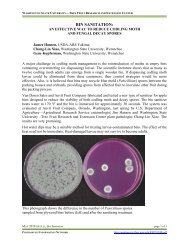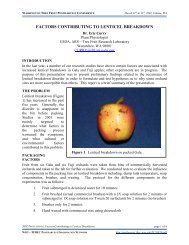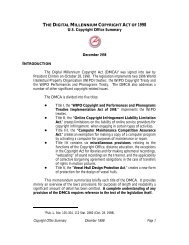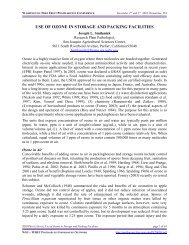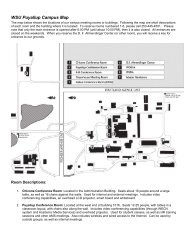You also want an ePaper? Increase the reach of your titles
YUMPU automatically turns print PDFs into web optimized ePapers that Google loves.
Six features seen in a typical <strong>XPS</strong> spectrum1. Sharp peaks due to photoelectrons created within the first few atomiclayers (elastically scattered).2. Multiplet splitting (occurs when unfilled shells contain unpairedelectrons).3. A broad structure due to electrons from deeper in the solid which areineslastically scattered (reduced KE) forms the background.4. Satellites (shake-off and shake-up) are due to a sudden change inCoulombic potential as the photoejected electron passes through thevalence band.
5. Plasmons which are created by collective excitations of the valence band• Extrinsic Plasmon: excited as the energetic PE propagatesthrough the solid after the photoelectric process.• Intrinsic Plasmon: screening response of the solid to the suddencreation of the core hole in one of its atomThe two kinds of Plasmon are indistinguishable.6. Auger peaks produced by x-rays (transitions from L to K shell: O KLL orC KLL).Photoelectron Auger electron
F 1s peakSharp Peak (core level)O 1s peak
x 10 3Doublet and satellites peaks for Ni and Cr 2p4540Ni 2pCr 2p35CPS3025SatSat20885 880 875 870 865 860 855 850Binding Energy (eV)<strong>Washington</strong> <strong>State</strong> <strong>University</strong>--Pullman, WAMultiplet splitting occurs when there are unfilled shells containing unpairedelectrons. For instance, transition metals with unfilled p and d orbitals and rareearths with unfilled f orbitals all show multiplet splitting.
Vacancy created by photoionization (unpaired electron left behind (after ionization))couples with a unpaired electron in the originally incompletely filled shell andgenerates splitting of the orbital (p, d or f orbitals).Example: Fe 2 O 3 has 5 unpaired electrons in the 3d shell as shown below.Following photoionization in the 3s shell, there are 2 possible final states.Schematic of Multiplet Splitting following photoionization in Fe 3+ and <strong>XPS</strong> spectrum
Satellites arise when a core electron is removed by a photoionization. Thereis a sudden change in the effective charge due to the loss of shieldingelectrons. (This perturbation induces a transition in which an electron from abonding orbital can be transferred to an anti-bonding orbital simultaneouslywith core ionization).Two types of satellite are detected.Shake-up: The outgoing electron interacts with a valence electron andexcites it (shakes it up) to a higher energy level. As a consequence theenergy core electron is reduced and a satellite structure appears a few eVbelow (KE scale) the core level position.Shake-off: The valence electron is ejected from the ion completely (to thecontinuum). Appears as a broadening of the core level peak or contributeto the inelastic background.
Shake-up satellites: distinct peaks a few eV below the main line.Shake-off satellites: broad feature at lower energy w.r.t. to main line.Ψnlm( r,θ , ψ ) = Y ( θ , ψ ) R ( r)lmn
PlasmonsThis feature is specific to clean surfaces.The photoelectron excites collectiveoscillations in the conduction band (freeelectrongas), so called Plasmons. (discreteenergy loss).353025x 10 3<strong>XPS</strong> Sp Si 2sSi 2sThe plasmon (bulk) energy isn: e density, e: charge of e,m: mass of e electron.h ω =p4πneh(m2)1/ 2CPS2015105plasmonplasmonSurface plasmon: bulk plasmon / 1.414.195 190 185 180 175 170 165 160 155 150 145Binding Energy (eV)<strong>Washington</strong> <strong>State</strong> <strong>University</strong>--Pullman, WAFor Al, Mg, Na etc… the energies are 15.3 eV, 10.6 eV and 5.7 eV, respectively.
Auger featuresAuger electron emission occurs also when x-rays impinge a sample. Augerelectron is initiated by the creation of an ion with an inner shell vacancy.surveyAuger electrons are emittedx 10in the relaxation of the excited480Cu 2p Peaks70ion. An electron from a higherlying energy level fills the inner60shell vacancy with the simultaneous 50emission of an Auger electron.40It is a three-electron process.3 Distinct Auger Peaks areseen in the data for CopperCPS302010Cu2s<strong>Washington</strong> <strong>State</strong> <strong>University</strong>--Pullman, WACu Auger Peaks1200 1000 800 600 400 200 0Binding Energy (eV)O1sCu3sCu3p
Chemical shift arises in the initial state from the displacement of the electroniccharge from the atom towards its ligands, reducing the electrostatic potential at theatom. There is a final state shift due to the polarization of the ligand by the core onthe central atom.Core electron BE in molecular systems exhibits chemical shifts which are simplyrelated to various quantitative measures of covalency. Greater the electronegativityof the ligands, the greater the BE of the core electron of the ligated atom.Basic concept: The core electrons feel an alteration inthe chemical environment when a change in thepotential (charge distribution) of the valence shelloccurs.For example: let’s assume that the core electrons areinside a hollow spherical charged shell. Each coreelectron then sees a potential V. A change in Q by ΔQgives a change in V.where ΔVisthechemical shiftΔV=R14πε0ΔQRCoreelectronsValence chargeQ
x 10 3Oxidized surfaces12Cr 2p ---data10CPS86Oxide peakElemental CrOxide peakElemental Cr4590 580 570Binding Energy (eV)Oxidized and clean Cr 2p spectra (left). Oxidized and clean Cu 2p spectra (right).The oxide layer resulted in extra peaks (shoulder at higher BE—left of the mainline). Satellites are also seen on the Cu 2p spectra.
Angular Distributions(C.S. Fadley, J.E.S. and R.P. (1974) 5 p 725-754)The mean free paths (IMFP) are in the range of 5 -100Å falling within 5 –40 Å forinorganic materials. To enhance the surface signal we can vary the photon energy—closer to the attenuation length minimum or decrease the angle of electron emissionrelative to a solid surface.For example: Au 4f IMFP is about 22Å (d) at angle of 90° using AlKα. The depth (d)probed by <strong>XPS</strong> becomes about 4-5 Å at angle of 10°.
Chemical BondingThe curve fitting of the mainhydrocarbon line (C x H y ) revealschemical shifts corresponding to• Ether and alcohol groups (C-O at 1.55eV higher BE),• Carbonyl groups (C=O at 2.8 eVhigher),• Ester and acid functional at 4.2 eV• Carbonate groups at 5.2 eV higherBE.Finally, the π- π* satellite at 291.5 eVappears at the extreme left.
Spin-orbit and lines intensityMultiplet splitting occurs when the system has unpaired electrons in the Valencelevels.Example: Mn 2+ 1s 2 2s 2 2p 6 3s 2 3p 6 3d 5 4s 2 (3d 5 all unpaired and with // spins)Also the total electronic angular momentum (j) is a combination of the orbital angular(l) and spin (s) momenta. The j-j coupling is equal to |L ± S| where L and S are thetotal orbital angular and spin momenta, respectively.For angular quantum number l ≠ 0 the line is a doublet. (p 1/2 , p 3/2 ).Splitting: Final states are given by: j + = l + s and j - = l – sExamples: For p orbitals the doublet will be p 1/2 and p 3/2 because l = 1 and s = ± 1/2therefore j - = 1/2 and j + =3/2.For d orbitals, the doublet will be d x1 and d x2 because l = and s = ± 1/2therefore j - = x1 and j + = x2 .
Intensity ratio is given by (2j - +1) / (2j + +1)For p orbitals the ratio is given by 2 x 1/2 +1 = 2 (p 1/2 ) and 2 x 3/2 +1 = 4(p 3/2 ). Therefore the ratios for p orbitals doublet is 1/2, for d orbitalsdoublet is 4/6 = 2/3Cr 2p spectrumAu 4f spectrumRatio = 1/2 Ratio = ??
<strong>XPS</strong>: It arises as a consequence of the build-up of a positive charge at thesurface of non-conducting specimens. The rate of photo-electron loss isgreater than that of their replacement from within the specimen.It produces a retarding field at the surface that wille -hνshift the peaks (reduce the KE of the ejected electrons).Suggestions:Static Charging1) Use of the adventitious Carbon line to correct any shift (most materialsexhibit a C 1s line).2) Deposition of a very thin layer of gold (as use in SEM).3) Use of a “flood gun” low energy electrons (0-5 eV).+ + + +-----
Static Charging (cont.)Auger: Sample charging is a function of the total electron yield, f (Σ). Σ isthe sum of secondary electron and backscattering coefficient.Σ > 1 samples charge positively. Auger (and <strong>XPS</strong>) peaks shift to lower KE(higher BE).Σ < 1 samples charge negatively. Auger (and <strong>XPS</strong>) peaks shift to higher KE(lower BE).Case 1, the emitted electrons have a reduced KE by a few tens of eVIdentification remains possibleCase 2, the KE of the emitted electrons increases due to the repulsive forcesbetween the charged surface and emitted electrons.Analysis is often impossible.
Peak Deconvolution (curve fitting)Photoelectron lines have a Lorenzian shape corresponding to the lifetime of the corehole that is created. Gaussian or Gaussian Lorentzian shape GL(30) curves are oftenused for curve fitting purposes.Deconvolution of the <strong>XPS</strong> Mo samples reveals the existence of several Mo species(Mo 0 , Mo4+, Mo6+ but others could also be detected: Mo3+ and Mo5+).
Peak Widths and IntensitiesPeak widths: it is a convolution of the natural width of the core level, the width ofthe x-ray line and the analyzer resolution:ΔE=222( ΔE+ ΔE+ ΔEnpa)1/ 2Intensities: Only the ratio of area of lines has some meaning (relative concentration).[ A]σ bζbλbηbIa=[ B] σ aζaλaηaIbσ: cross-section; ζ: fraction of PE events (w/o intrinsic plasmon excitation); λ:mean free path; η: KE dependent spectrometer transmission and I : area of the line
Quantitative Analysis1. Use of standards:I xis the amplitude of the element X in your sample,I x,stdis the amplitude of the element X in pure materialThe concentration of X in your sample is THEN given by C x = I x / I x,stdPROBLEM with this approach is that you need a large No of Standards.2. Modify Method:It introduces the relative sensitivity factor, S xbased upon one pure elementstandard (usually Ag, silver standard). So, if we want to calculate S x:sensitivity for element X from a compound X aY bwe could do it by using:Sx=( A+ B)AIIxAg(pure)
Quantitative Analysis (cont.)Sx=( A+ B)AIIxAg(pure)Where I xis the amplitude of the known compound, (A+B)/A is the 1 /fraction of X atoms and I x/ I Agthe ratio of peak to peak amplitudes.THEN from an unknown sample: C x= I x/ I Ag. S x= concentrationOR to make it self consistent C x=(I x/S x)/∑ a (I a/S a)where I xand I aare measured and S xand S aas mentioned aboveare obtained from standards
Deconvolution of Si 2p spectrum<strong>XPS</strong>Peak41 (free software)



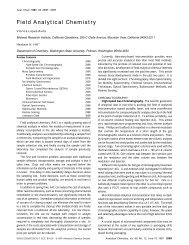
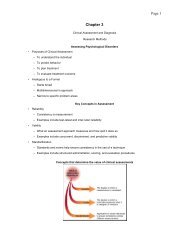

![Graduate School Policies & Procedures Manual 2011 - 2012 [PDF]](https://img.yumpu.com/50747405/1/190x245/graduate-school-policies-procedures-manual-2011-2012-pdf.jpg?quality=85)

